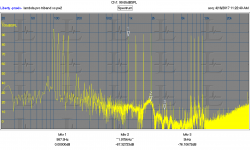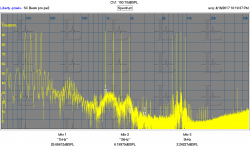Thinking about the Spectral contamination test I need to make a revision that matches bins at 48 KHz multiple sample rates.
For what its worth I found two useful calculators. First for testing ADC's and DACs : https://ez.analog.com/docs/DOC-12357 It helps pick a frequency that will exercise every bit/step in a tone. If you use a frequency such as 1 KHz with a 48 KHz sample rate the sampling can hide things. (this is an error I have been making). It suggested 1057.250977 for a 48 KHz sample rate.
Second a bin center calculator Tech Stuff - Acoustic Calculators Will give bin centers for FFT depth and sample rates.
Lots of work ahead.
For what its worth I found two useful calculators. First for testing ADC's and DACs : https://ez.analog.com/docs/DOC-12357 It helps pick a frequency that will exercise every bit/step in a tone. If you use a frequency such as 1 KHz with a 48 KHz sample rate the sampling can hide things. (this is an error I have been making). It suggested 1057.250977 for a 48 KHz sample rate.
Second a bin center calculator Tech Stuff - Acoustic Calculators Will give bin centers for FFT depth and sample rates.
Lots of work ahead.
The Jensalyzer should work with any software that can use an USB audio interface (and that's pretty much all the audio testing sofwtare packages I am aware of, except maybe MLSSA and CLIO systems). I'll use it with MATAA.
Hi - slightly OT, but whilst contemplating signing up for an RTX I thought I would take MATAA for a test drive; I like the design. However, I'm having trouble making it work on Windows 10.
The TestTone binary from github works, but there's a few second delay before it generates a tone and TestDevices takes an age to run too; though it does return a reasonable output. The long delay before making a sound doesn't feel right and I think it's interfering with the MATAA code.
I've tried TestTone with both a standard ASIO Realtek driver and ASIO4ALL, but no dice. Other ASIO apps seem to work fine.
Has anyone had better luck than me?
Thanks.
You need a second soundcard that is >1 order of magnitude better then the device under test.Does anyone know of a good way to measure only the input or output response of a DUT sound card?
Sent from my iPhone using Tapatalk
The question is the FFT algorithm itself, its how a large or very large FFT RMS array is presented on the x-axis of your screen. This means, ordinary SW uses only the peak reading (as the peak Detector mode) what is required to show the harmonic's.
In case of noise, no FFT Window have to be applied and the Detector mode has to be Average (Do not mix up spectrum average and Detector Average).
For clarification see picture below.
Or simple build your own IM's, while for bass speakers different frequencies are required. Here my Five IM Cluster. See picture below using my Multi-Sine using upcoming DSD Generator and PCM acquisition on RME ADI-2 Pro.
To the questions about AP:
- The have a tracking notch filter build
- The FFT resolution is limited (lower 2^n spec's)
- Desktop integration ??
- Have in addition an 2 Mhz ADC
....
Hp
Thanks for the comments Hp
Thinking about the Spectral contamination test I need to make a revision that matches bins at 48 KHz multiple sample rates.
For what its worth I found two useful calculators. First for testing ADC's and DACs : https://ez.analog.com/docs/DOC-12357 It helps pick a frequency that will exercise every bit/step in a tone. If you use a frequency such as 1 KHz with a 48 KHz sample rate the sampling can hide things. (this is an error I have been making). It suggested 1057.250977 for a 48 KHz sample rate.
Second a bin center calculator Tech Stuff - Acoustic Calculators Will give bin centers for FFT depth and sample rates.
Lots of work ahead.
Thanks much Demian for the attachment and the pointers, i will go through them.
This is a triband spectral contamination plot of a Stax Lambda Pro at 100 dBSPL (loud if it were on your ears) Microphone is a B&K 4145, preamp is an HP 15109. I have no way right now to crosscheck the distortions (such as they are). I used coherent averaging and 50 averages to get the noise down. The Stax are open ear so ambient noise is not attenuated. I used Praxis for this. I'll be happy to attempt it with ARTA or any other package if its reasonably possible.
I tried with the B&K preamp but I could not get the noise down in a useful way. The 2609 measuring amp was not setup to access the mike preamp directly.
I tried with the B&K preamp but I could not get the noise down in a useful way. The 2609 measuring amp was not setup to access the mike preamp directly.
Attachments
For context here is a Beats pro dynamic headphone on the same measurement at the same level (100 dB SPL). You can see the IM products around the high band tones. The noise floor also reflects differences.
Attachments
Last edited:
You need a second soundcard that is >1 order of magnitude better then the device under test.
I am wondering whether a digital output of an MLS signal connected to the DUT analog input would work for testing an ADC performance.
Sent from my iPhone using Tapatalk
For context here is a Beats pro dynamic headphone on the same measurement at the same level (100 dB SPL). You can see the IM products around the high band tones. The noise floor also reflects differences.
Really insightful posts. Thanks a lot for posting these.
Is there a single tone test or ambient measurement plot to show comparison with this?
I plan to try out this test on my 4-way active speaker based on the spreadsheet, next time i get a chance.
It makes a lot of sense. speaker drivers being mechanical devices, i have often wondered how they behave when playing signals making up multiple frequencies in their pass band. What the effect of this frequency mix changing rapidly is.
A sweep of sine waves perhaps doesn't bring out all the gremlins.
Some speakers sound very good with slow, clean music (perhaps why some audiophiles prefer such music), but completely fall apart with complex music exciting the entire spectrum and such spectrum changing rapidly
Btw, wonder how these multi-tone signals are generated for stimulus. I will have to check if REW or ARTA allow this.
A sweep of sine waves perhaps doesn't bring out all the gremlins.
Some speakers sound very good with slow, clean music (perhaps why some audiophiles prefer such music), but completely fall apart with complex music exciting the entire spectrum and such spectrum changing rapidly
Btw, wonder how these multi-tone signals are generated for stimulus. I will have to check if REW or ARTA allow this.
Last edited:
I used TrueRTA to easily switch from scope to spectrum, and get a chirp response spectrum. Not too bad for easy use with amp restoration.
Now enjoying REW as it allows more control over fft spectrum, and provides automated harmonic identification and THD and THD+N, plus all IM formats. It's sweep measurement has good control, and ease to format for display. But it doesn't do an oscilloscope for cross-referencing waveform.
Now enjoying REW as it allows more control over fft spectrum, and provides automated harmonic identification and THD and THD+N, plus all IM formats. It's sweep measurement has good control, and ease to format for display. But it doesn't do an oscilloscope for cross-referencing waveform.
For context here is a Beats pro dynamic headphone on the same measurement at the same level (100 dB SPL). You can see the IM products around the high band tones. The noise floor also reflects differences.
You also want to understand the bending modes of the diaphragm etc to fully understand what is going on...
Sent from my iPhone using Tapatalk
Hi - slightly OT, but whilst contemplating signing up for an RTX I thought I would take MATAA for a test drive; I like the design. However, I'm having trouble making it work on Windows 10.
The TestTone binary from github works, but there's a few second delay before it generates a tone and TestDevices takes an age to run too; though it does return a reasonable output. The long delay before making a sound doesn't feel right and I think it's interfering with the MATAA code.
I've tried TestTone with both a standard ASIO Realtek driver and ASIO4ALL, but no dice. Other ASIO apps seem to work fine.
Has anyone had better luck than me?
Thanks.
Hi brickj, please use the MATAA mailinglist or start a new thread to discuss this.
I'd like to add Realtime Analyzer
Download link Download Realtime Analyzer
Quite reasonably priced too, and seems to yield some good measurements based on my experience.
Download link Download Realtime Analyzer
Quite reasonably priced too, and seems to yield some good measurements based on my experience.
Worked with REW, HOLM, ARTA, TrueRTA, SoundEasy and played with some other packages. When done right they all give comparable results. They all have their strong points. When you know what you are looking for, it all boils down to figuring out click sequences.
After multiple meanderings, ARTA has become my primary measuring program, with TrueRTA for quick-and-dirty stuff.
After multiple meanderings, ARTA has become my primary measuring program, with TrueRTA for quick-and-dirty stuff.
Worked with REW, HOLM, ARTA, TrueRTA, SoundEasy and played with some other packages. When done right they all give comparable results. They all have their strong points. When you know what you are looking for, it all boils down to figuring out click sequences.
After multiple meanderings, ARTA has become my primary measuring program, with TrueRTA for quick-and-dirty stuff.
thanks for the review
it helps a lot
dennis h
- Status
- This old topic is closed. If you want to reopen this topic, contact a moderator using the "Report Post" button.
- Home
- Design & Build
- Equipment & Tools
- Analyzer Software Overview

